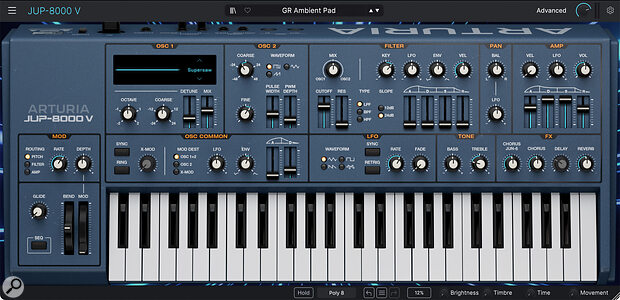 The Roland JP‑8000 lives again in software form!
The Roland JP‑8000 lives again in software form!
V Collection 11 is here, and yes, it’s bigger than before, better than before and better value than ever.
Yet another year, yet another V Collection and, as has become traditional with previous incarnations, the improvements in V Collection 11 comprise a combination of new instruments, some existing instruments that are new to the Collection, updates to instruments already in the Collection, and new sounds that may (or may not) be exactly what you need.
Jup‑8000V
The most eye‑catching of the new instruments is a recreation of the Roland JP‑8000, although I’m not sure why Arturia chose this in preference to other — possibly more useful — synths that they could have modelled. After all, the big selling points of the original were its SuperSaw waveform and its Feedback Oscillator, both of which could be the basis of interesting and, at the time, innovative patches. There are now many other ways to obtain these timbres, but somebody in Grenoble must still be a big fan and have managed to persuade everyone else of the JP’s desirability.
Arturia’s marketing materials for JUP‑8000 V lean heavily toward EDM sub‑genres such as Goa, trance, and something called progressive underground, which sounds to me like a tube train that leans slightly to the left. But despite the company’s concentration in these areas, it would be a mistake to think that the soft synth is constrained within these walls. While I wouldn’t normally choose to use an instrument that promises me a “mainstage breakdown” (whatever that may be) it took me just moments to create some lovely pads, leads and basses and, no doubt, greater time spent with it would have led to even more interesting sounds. Unfortunately, JUP‑8000 V exhibits a problem that was endemic to Arturia soft synths in years past: the dual oscillators in each voice have a non‑random and constant phase offset assigned when you play them. This means that you can program a sound and play chords that exhibit an extreme dee‑dee‑doo‑doo‑doo‑doo‑doo‑dah effect — sometimes even missing notes entirely because of cancellation — as you cycle through the voices. I don’t know whether the original synth ever did this, but I wish that JUP‑8000 V didn’t. That issue aside, it’s a powerful ‘virtual‑virtual‑analogue’ synthesizer, and adds yet another colour to Arturia’s already extensive palette.
Pure LoFi
For me, a more interesting addition is Pure LoFi, which offers a highly unusual slant on sound generation. Built largely upon sample‑based synthesis (but with extra spice in the form of a little analogue modelling and wavetable synthesis) it offers numerous ways to degrade the initial signal. These include the ability to replay the samples and oscillator waveforms through emulations of the signal paths of early digital samplers such as the Fairlight and Emulator, the addition of various noise types from a dedicated noise engine, and a ‘lofi’ mode that adds the types of imperfections and coloration imparted by tape replay and aging speakers.
 Pure LoFi is a reminder that V Collection is more than just vintage synth recreations.
Pure LoFi is a reminder that V Collection is more than just vintage synth recreations.
Interestingly, applying the lofi parameters doesn’t make Pure LoFi sound low‑quality; if anything, they can add to its appeal. You...
You are reading one of the locked Subscribers-only articles from our latest 5 issues.
You've read 30% of this article for FREE, so to continue reading...
- ✅ Log in - if you have a Digital Subscription you bought from SoundOnSound.com
- ⬇️ Buy & Download this Single Article in PDF format £0.83 GBP$1.49 USD
For less than the price of a coffee, buy now and immediately download to your computer, tablet or mobile. - ⬇️ ⬇️ ⬇️ Buy & Download the FULL ISSUE PDF
Our 'full SOS magazine' for smartphone/tablet/computer. More info... - 📲 Buy a DIGITAL subscription (or 📖 📲 Print + Digital sub)
Instantly unlock ALL Premium web articles! We often release online-only content.
Visit our ShopStore.
